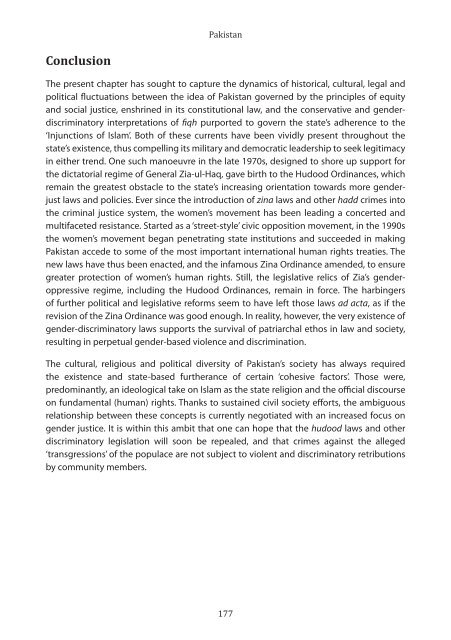control and sexuality
control and sexuality
control and sexuality
- No tags were found...
You also want an ePaper? Increase the reach of your titles
YUMPU automatically turns print PDFs into web optimized ePapers that Google loves.
PakistanConclusionThe present chapter has sought to capture the dynamics of historical, cultural, legal <strong>and</strong>political fluctuations between the idea of Pakistan governed by the principles of equity<strong>and</strong> social justice, enshrined in its constitutional law, <strong>and</strong> the conservative <strong>and</strong> genderdiscriminatoryinterpretations of fiqh purported to govern the state’s adherence to the‘Injunctions of Islam’. Both of these currents have been vividly present throughout thestate’s existence, thus compelling its military <strong>and</strong> democratic leadership to seek legitimacyin either trend. One such manoeuvre in the late 1970s, designed to shore up support forthe dictatorial regime of General Zia-ul-Haq, gave birth to the Hudood Ordinances, whichremain the greatest obstacle to the state’s increasing orientation towards more genderjustlaws <strong>and</strong> policies. Ever since the introduction of zina laws <strong>and</strong> other hadd crimes intothe criminal justice system, the women’s movement has been leading a concerted <strong>and</strong>multifaceted resistance. Started as a ‘street-style’ civic opposition movement, in the 1990sthe women’s movement began penetrating state institutions <strong>and</strong> succeeded in makingPakistan accede to some of the most important international human rights treaties. Thenew laws have thus been enacted, <strong>and</strong> the infamous Zina Ordinance amended, to ensuregreater protection of women’s human rights. Still, the legislative relics of Zia’s genderoppressiveregime, including the Hudood Ordinances, remain in force. The harbingersof further political <strong>and</strong> legislative reforms seem to have left those laws ad acta, as if therevision of the Zina Ordinance was good enough. In reality, however, the very existence ofgender-discriminatory laws supports the survival of patriarchal ethos in law <strong>and</strong> society,resulting in perpetual gender-based violence <strong>and</strong> discrimination.The cultural, religious <strong>and</strong> political diversity of Pakistan’s society has always requiredthe existence <strong>and</strong> state-based furtherance of certain ‘cohesive factors’. Those were,predominantly, an ideological take on Islam as the state religion <strong>and</strong> the official discourseon fundamental (human) rights. Thanks to sustained civil society efforts, the ambiguousrelationship between these concepts is currently negotiated with an increased focus ongender justice. It is within this ambit that one can hope that the hudood laws <strong>and</strong> otherdiscriminatory legislation will soon be repealed, <strong>and</strong> that crimes against the alleged‘transgressions’ of the populace are not subject to violent <strong>and</strong> discriminatory retributionsby community members.177


